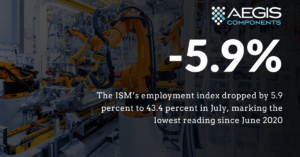
July sees significant drops in production and employment, with the industry facing continued challenges despite stable pricing.
In July, U.S. manufacturing activity reached an 8-month low due to weak demand, declining production, and reduced headcounts. The Institute for Supply Management’s (ISM) factory index, known as the PMI, fell by 1.7 percent from June, landing at 46.8. A reading below 50.0 indicates industry contraction. Despite the downturn, there was a positive aspect in the form of stable pricing, which saw a slight increase of 0.8 percent to reach 52.9 in July. Prices have remained relatively low, with minimal growth, indicating that cost management has been effective.
Inventory levels across most industries were reported as adequate, though there was an unexpected slowdown in supplier deliveries in July. The supplier deliveries index rose to 52.6 percent, up by 2.8 percentage points from June’s 49.8 percent. In this index, a reading above 50 percent signals slower deliveries, typically seen when the economy strengthens and customer demand increases. The electronics industry, in particular, reported good availability of parts, although some materials were still occasionally missing. Companies have been ordering below typical levels as they work through existing inventories, with a return to normal ordering trends anticipated in the second half of 2024.

Employment Levels Fall
The ISM’s employment index dropped by 5.9 percent to 43.4 percent in July, marking the lowest reading since June 2020. Companies have been reducing their workforces through layoffs, attrition, and hiring freezes. There was a notable increase in staff reductions in July compared to June. U.S. manufacturing activity has moved deeper into contraction, with weak demand, declining output, and generally accommodative inputs. This slowdown in demand was evident as the new orders index fell further into contraction, new export orders continued to decline, the backlog of orders remained in strong contraction territory, and customers’ inventories moved to the higher end of being too low.
Output, measured by the production and employment indexes, declined compared to June, with a combined 8.5-percentage point drop impacting the PMI. Companies continued to reduce production levels in response to ongoing headcount reductions in July. Inputs, which include supplier deliveries, inventories, prices, and imports, generally remained supportive of future demand growth. However, demand remains subdued as companies are reluctant to invest in capital and inventory due to current federal monetary policy and other conditions. This reduction in production execution compared to June is likely contributing to revenue declines and adding pressure on profitability. Suppliers, meanwhile, continue to have capacity, with improving lead times and less severe shortages.
In July, 86 percent of manufacturing gross domestic product (GDP) contracted, up from 62 percent in June. Of greater concern is the fact that 53 percent of sector GDP registered a composite PMI calculation at or below 45 percent, a significant indicator of overall manufacturing weakness, which is 39 percentage points higher than the 14 percent reported in June.
Aegis Components provides electronic and electrical components from verified suppliers to ensure that the quality you expect is delivered every time.
Fill up the form and our team will get back to you within 24 hours.